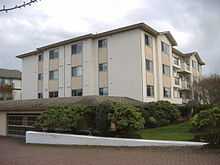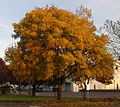Sidney, British Columbia
| Town of Sidney | |
|---|---|
| Town | |
 | |
 | |
| Coordinates: 48°39′2″N 123°23′55″W / 48.65056°N 123.39861°WCoordinates: 48°39′2″N 123°23′55″W / 48.65056°N 123.39861°W | |
| Country |
|
| Province |
|
| Region | Vancouver Island |
| Regional district | Capital Regional District |
| Incorporated | 1952 |
| Government | |
| • Governing body | Sidney Town Council |
| • Mayor | Larry Cross |
| • MP | Elizabeth May |
| • MLA | Gary Holman |
| Area | |
| • Total | 5.12 km2 (1.98 sq mi) |
| Elevation | 5 m (16 ft) |
| Population (2011) | |
| • Total | 11,583 |
| • Density | 2,183.6/km2 (5,655/sq mi) |
| Time zone | PST (UTC-8) |
| Postal code | V8L |
| Area code(s) | 250 |
| Highways | 17 |
| Waterways | Haro Strait |
| Website | Town of Sidney |


Sidney is a town located at the northern end of the Saanich Peninsula, on Vancouver Island in the Canadian province of British Columbia. It is one of the 13 Greater Victoria municipalities. It has a population of approximately 11,583. Sidney is located just east of Victoria International Airport, and a few kilometres south of BC Ferries' Swartz Bay Terminal. The town is also the only Canadian port-of-call in the Washington State Ferry system, with ferries running from Sidney to the San Juan Islands and Anacortes. Sidney is located along Highway 17, which bisects the town from north to south. It is generally considered part of the Victoria metropolitan area.
The town west of Highway 17 (also called the Pat Bay Highway) has a mixture of single-family residences and light industry. The majority of the town is located east of highway 17. Single-family units are also present east of the highway, but the eastern sector also has many condominium-type buildings, plus most of the service and retail outlets. The island-studded Haro Strait, part of the Salish Sea forms Sidney's eastern boundary. There is a large boating and marine industry in the area, ranging from marinas to boatbuilders and marine suppliers.
Population
According to Statistics Canada, Sidney had a population of 11,583 in 2011—a reduction of -0.1% from 2010. Sidney is well known for having an abundance of senior citizens, producing a median age of 50.7 in 2001 as compared with the British Columbia median age of 38.4. It is therefore nicknamed "land of the newly-wed and the nearly dead". The population density per square kilometre was 2,167. In 2006 Sidney had more than 35% of their population over the age of 65.
| Canada 2006 Census | Population | % of Total Population | |
|---|---|---|---|
| Visible minority group Source:[1] | Chinese | 95 | 0.9% |
| South Asian | 65 | 0.6% | |
| Black | 20 | 0.2% | |
| Filipino | 25 | 0.2% | |
| Latin American | 45 | 0.4% | |
| Southeast Asian | 10 | 0.1% | |
| Arab | 0 | 0% | |
| West Asian | 0 | 0% | |
| Korean | 0 | 0% | |
| Japanese | 50 | 0.5% | |
| Other visible minority | 20 | 0.2% | |
| Mixed visible minority | 55 | 0.5% | |
| Total visible minority population | 405 | 3.7% | |
| Aboriginal group Source:[2] | First Nations | 250 | 2.3% |
| Métis | 0 | 0% | |
| Inuit | 0 | 0% | |
| Total Aboriginal population | 250 | 2.3% | |
| White | 10,355 | 94.1% | |
| Total population | 11,010 | 100% | |
Labour force
Sidney is mainly an industrial town, with most people working in the construction, manufacturing, and warehousing fields (26%). Retail accounts for approximately 10% of the employment. Healthcare and social assistance employs 13%. There are over 4,000 people employed in Sidney, with an unemployment rate of 6.1%. It should also be taken into consideration that some of this labour force commutes from neighbouring municipalities, such as Saanich or Victoria. The median income is $24,638. The median income for a household in the town is $56,115. Renting costs in Sidney have increased substantially over the past few years, with a Standard 2 Bedroom Suite reaching as much as $1200 a month.
Government
The Town of Sidney is a municipality governed by an elected Council. The elected Council, 2011-2014 consists of one Mayor and six Councilors. Mayor Larry Cross, Councilor Tim Chad, Councillor Melissa Hailey, Councillor Mervyn Lougher-Goodey, Councilor Marilyn Loveless, Councillor Kenny Podmore, Councilor Steve Price.
Education
Public schools serving Sidney residents are operated by School District 63 Saanich. These include Sidney Elementary School, North Saanich Middle School, and Parkland Secondary School.
Sister city
On June 30, 2008 the Sidney Sister Cities Association and the town of Sidney, BC declared the twinning of Sidney and Niimi, Okayama, Japan. This was Sidney's third sister city, following Cairns, Queensland, Australia and Anacortes, Washington, United States.
Attractions
Sidney's main attraction is its position on the Salish Sea. Sidney-by-the-Sea is the gateway to the southern Gulf Islands National Park Reserve, and is a popular eco-tourist destination, with whale-watching, bird-watching, kayaking and scuba-diving. It is home to the new Shaw Ocean Discovery Centre. Shoal Harbour Migratory Bird Sanctuary is located within Sidney and the adjoining Sidney Channel Important Bird Area, an internationally recognized site important to a variety of seabirds and waterfowl.
Sidney has its own local history museum, the Sidney Museum and Archives, which features displays about the history of the surrounding Peninsula as well as numerous temporary exhibits. As home to the Victoria International Airport Sidney also hosts the British Columbia Aviation Museum which features displays, artifacts, restored historical aircraft and an ongoing vintage aircraft restoration workshop.
During the summer, Sidney hosts a very popular street market on Thursday evenings on the main street (Beacon). "Sidney days" is another popular event that occurs at the beginning of July. To celebrate, Sidney has a parade, a popular build-a-boat contest, a small fair and fireworks in the evening. In the winter, Sidney has a holiday parade as well as a lighted sailpast boat parade. Sidney has many dining places including Greek, Thai, Chinese and west-coast restaurants. Sidney is officially Canada's only booktown, with 12 bookstores. It also has almost as many coffee joints and cafes to sit and read in.
Sidney has a well maintained boat ramp for trailerable boats with a dock for queuing up, it is located next to the Washington state ferry terminal.
Physiography

Almost all of the land within Sidney's boundary is either flat or very gently sloping, providing a topography which is favourable for the town's elderly people. Most soils are clayey, and poorly drained in their natural state. In some parts of town, this clay is overlain by deposits of sand and gravel which are well drained.
Climate
Sidney enjoys a cool Mediterranean climate (Csb) with year-round mild temperatures and moderate rainfall. Most years see very little snow. Daily temperatures seldom climb above 31°C, or dip below -7°C. In the mildest winters, minimum temperatures stay above -3°C. Damaging winds are less frequent than in most other maritime areas of Canada.
Fauna
The environs of Sidney provides habitat for a diverse array of fish and wildlife, both terrestrial and marine, coming and going with the seasons. For this reason it is a growing mecca for bird watchers, whale watchers, scuba-divers and eco-tourism. Undoubtedly, Sidney's most famous inhabitant is the handsome Bufflehead featured prominently on its Coat of Arms. The Bufflehead is just one of many species of waterfowl that overwinter in Shoal Harbour Migratory Bird Sanctuary, one of the oldest marine sanctuaries on the west coast. Sidney overlooks Sidney Channel Important Bird Area, an internationally recognized site of major importance for many species of seabirds such as Common Murres, Rhinoceros Auklet, Pigeon Guillemots, Murrelets, three species of Cormorants, and several gull species, including the unusual Heermann's Gull. One of Sidney's most famous residents is the Bald Eagle which has nested continuously in 'Beaufort Grove' for twenty-five years. In summer large numbers of Great Blue Herons gather in Roberts Bay (part of Shoal Harbour Sanctuary) to feed on the abundant small fish. A variety of songbirds (Towhees, American robins, Bewick's and Winter wrens, Bushtits, Chickadees etc.) are found in back yards, along with the common Northwestern Crow, and introduced species such as the Common Starling and House Sparrow. The airport lands around Sidney are the only place in North America where the beautiful song of the European Skylark can be heard.
Marine mammals include the ubiquitous Harbour Seal and the small Harbour Porpoise. Occasionally Gray Whales and killer whales can be seen from Sidney's waterfront. Marine-adapted River Otters are common coastal inhabitants, along with Raccoon, and Mink. Adjacent woodlands and farmlands are home to the small, shy Black-tailed Deer. In recent years, the introduced, invasive Eastern Grey Squirrel has become abundant.
The waters around Sidney once supported a large sports fishery, based largely on Chinook Salmon, along with ground fish such as ling cod, and various Rock Fish, or Sebastes, but overfishing and poor management have greatly reduced the sports fishery. Also, ecological change and the decline of critical forage species such as the Pacific Herring and the Sand Lance have had significant impacts on the larger predators, including salmon, killer whales and seabirds. Many of the common fish species and other marine fauna can be seen at the Shaw Ocean Discovery Centre on the Sidney waterfront.
Flora
Sidney is situated within the Coastal Douglas fir ecosystem, one of the most restricted ecosystems in Canada, dominated by large Douglas Firs, along with its most distinctive species, the Arbutus and Garry Oak in drier exposures, and the aptly named Big Leaf Maple, and Western Red Cedar in damper sites. Deciduous trees include the black cottonwood, Douglas Maple, red alder, Pacific dogwood, bitter cherry, Pacific crab apple, cascara, quaking aspen, hawthorn and several species of willow. Coastal areas contain several unique plant communities including Sea Asparagus, Salt grass and Eelgrass, documented by the renowned botanist and explorer, John Macoun, after he retired as curator of the National Museum in 1912.
Many non-native plants also occur, including many invasive species such as English Ivy, Scotch broom, Laurel-leafed Daphne, Himalayan blackberry, chicory, Queen Anne's Lace, and red clover. Long-established exotic trees include London plane, horsechestnut, flowering cherry, flowering plum, Norway maple, sycamore maple, Japanese maple, catalpa and tulip tree. In recent years the American sweetgum, Freeman maple and Chinese windmill palm have become very popular.
Gallery of Sidney
-

Advisory sign posted during nesting season of Northwestern Crow, with Sidney Town Hall in background.
-

Northwestern Crow on Sidney Town Hall lawn.
-
Freeman Maple at Mary Winspear Centre.
-
London Plane at Mary Winspear Centre.
-

Tulip Tree
-
Red Maple
-
American Sweetgum
-
Norway Maple at Sidney Town Hall; a commemorative tree planted in 1967.
-
The Sidney Summer Market is held on Beacon Ave. late every Thursday over the summer.
-
Common Horsechestnut
References
- ↑ "Community Profiles from the 2006 Census, Statistics Canada - Census Subdivision". 2.statcan.gc.ca. 2010-12-06. Retrieved 2013-04-13.
- ↑ "Aboriginal Peoples - Data table". 2.statcan.ca. 2010-10-06. Retrieved 2013-04-13.
External links
- Town of Sidney - Official website
- Sidney & North Saanich
- WSF Sidney B.C. terminal info
- Population Fact Sheets
- Parkland Secondary homepage
| ||||||||||||||
| ||||||||
| |||||
| |||||||||||||||||






